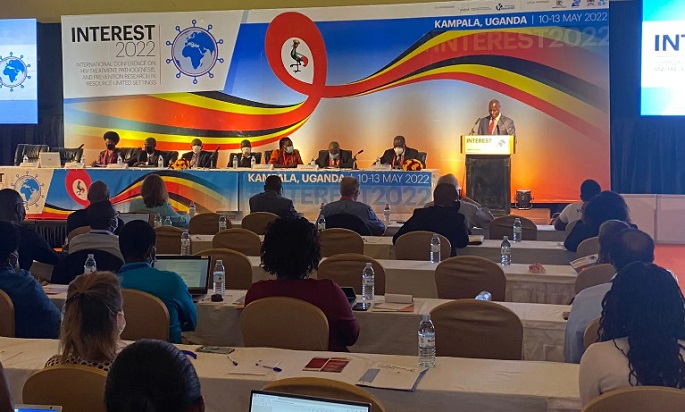Participants attending the conference
By Cassidy Derrick Mwanje
With 550 participants from 46 countries, INTEREST 2022 returns to Uganda after 16 years where it was founded in 2007.
This year’s conference is the first hybrid INTEREST conference. It has taken place in different locations in sub-Saharan Africa namely; Senegal (2008, 2013), Zambia (2009, 2014), Kenya, Zimbabwe, Cameroon, Malawi, Rwanda, Ghana and virtually during Covid. The conference provides a platform to exchange pivotal findings, promote collaboration, and share experiences. It also provides young researchers with a unique opportunity to present their work, attend mentoring sessions with senior scientists and network with their peers.
Speaking to the press on Tuesday, Dr. Kwasi Torpey of the University of Ghana, Dr. Elly Katabira of Makerere University College of Health Sciences, Dr. Andrew Kambugu, the Sande McKinnell Executive Director of the Infectious Diseases Institute, Makerere University and Dr Sabrina Bakeera-Kitaka, a Senior Lecturer at the Department of Paediatrics and Child health at the Makerere University, College of Health Sciences said that the conference basically is to share ideas of expertise and experiences in the response to HIV AIDS.
The experts revealed that INTEREST is intended at developing the capacity of young African researchers and implementers in the HIV response.
“The INTEREST conference is also to galvanize the different countries so that they are able to advance the implementation of HIV program and achieve epidemic control.”
Dr. Katabira emphasized that the idea of INTEREST is to empower young scientists.
“These are the future of any implementation of any intervention in any given county. In Uganda, it is usually the older ones who do research. When we do research, we don’t do it alone but with the young people. Although the young people don’t get the opportunity to come with us, because it is not possible to fund them to follow us to learn from where going. The reason why INTEREST is provided for Africa is to go and involve the people within that country,” he said.
“Everybody who does research in any country expects to present their work somewhere but the opportunities are limited particularly because the conferences where the results are given out are often in big countries and these people (young researchers) can’t get there. However, when we bring the conference with in the country and the objective is to mobilize the young people who are doing work in HIV in that given country, it gives them the opportunity to present their work, to learn how to make presentations internationally. People from here not only will they learn to implement what they have learnt, how to treat their patients but also they will learn how to discuss and interact with some of the senior researchers who are here,” he added.
The scientists are optimistic that one day there will be HIV/AIDS cure.
Giving highlights on UPHIA 2020 report, Joshua Musinguzi, Assistant Commissioner, AIDS Control Programme at the Ministry of Health revealed that they managed to get 88.2% response.
Represented by Kirungi Wilford, a medical epidemiologist at the Ministry of Health, Musinguzi revealed that about 13% of households in Uganda indicated that they were HIV affected with at least one individual living with the virus.
“In terms of the prevalence of households headed by someone living with HIV, this was at around 9%. The majority are female-headed families.”
The survey determined HIV incidence in Uganda to be 0.32%, predominantly are feminine epidemic and the most affected age group were 24 to 34. By gender, young women aged 15 to 24 were twice likely to have higher incidence than the general population.
“HIV prevalence was determined to be 5.8% among all adults, with wide heterogeneited across the country, from the lowest of 2.1% in Northeast (Karamoja region) to the highest of about 8.1% in the central region.”
Musinguzi added that previous HIV testing among HIV-infected individuals, they expect to have diagnosed most of the individuals by now but it wasn’t the case. He said that about 1 in 5 were not yet diagnosed, about 03% were diagnosed but not yet linked to treatment but the majority were already linked to treatment.
Highlighting UNAIDS Global Report-Key Issues, Dr. Jotham Mubangizi, Ag. Country Director said that Uganda was among 8 Countries globally that have achieved 90-50-30.
He said that the risk of dying from COVID-19 among people living with HIV was double that of the general population.
“Double jeopardy of HIV and COVID.”
Data shows that Uganda was among 17 of the 32 countries, whose demand and fulfillment of family planning services was disparity not very large (25%). While TB deaths fall by more than half-Progress is much slower in Cameroon, the DRC, Uganda and Zambia-they are among the 30 countries that accounted for 88% of all TB-related deaths among PLHIV.
“Though Uganda reduced child HIV infections by 70%, half of new child infections worldwide were in anly seven countries: Nigeria (14%), Mozambique and South Africa 18% each), Tanzania (7%), DRC (6), Zambia (5%) and Uganda (3%).”
Accordingly, Uganda was among the 11 countries that reported high levels of violence (physical, sexual and/or emotional)-children and women-19.25%-75%.
Also study indicates that the region still experiences high rates of stigma, discrimination and human rights, Social, economic, racial and gender inequalities.
“Kev populations in most ESA countries can’t associate and access services freely-there is continued shrinking space, due to restrictive and discriminatory laws, policies and practices,” shows the study.
Mr. Mugangizi also revealed that there is a high unmet family planning need, especially for young women aged 15-24years.
According to him, today if leaders fail to tackle inequalities the world could face 7.7 million AIDS-related deaths over the next 10 years and continued devastation from pandemics.
“If the transformative measures needed to end AIDS are not taken, the world will also stay trapped in the COVID-19 crisis and remain dangerously unprepared for the pandemics to come,” he warned.
According to Uganda AIDS Commission – UAC, there were 14 million PLHIV, new infections and 22,000 AIDS-related deaths in 2020.
Dr. Nelson Musoba, Director General, UAC says the significant progress in last decade; HIV incidence, morbidity and mortality and vertical infections are all falling.
“However, it fell short of SDG targets of 75% reduction in new infections and AIDS-related deaths, only achieving 60% decline by 2020.”
Data also indicates achieving 90% reduction in new infections and AIDS death over the next decade is most desirable.






